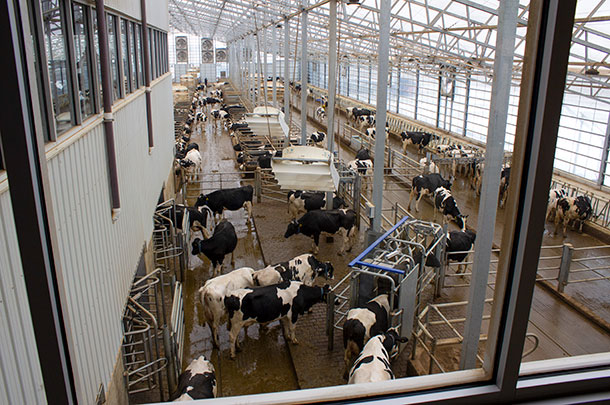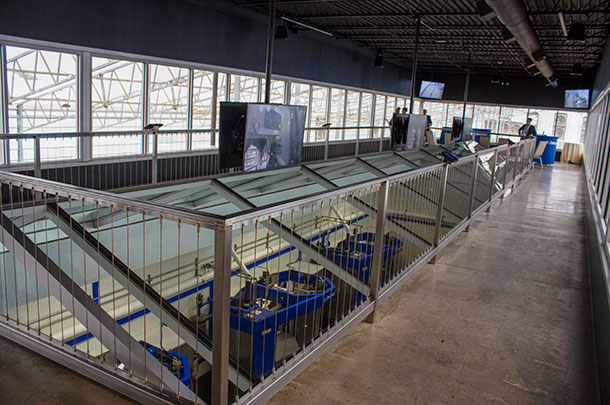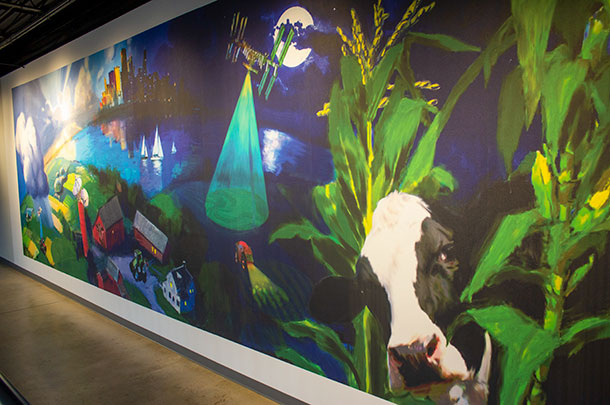“This really meets our dairy farm’s sustainability effort and well-being for cows. It is a nice step forward in productivity and comfort,” Mike McCloskey said at the event on Nov. 14. Then he added, “Not just a step, it truly is a jump forward in that effort.”
The new automated milking facility sits on the same site as the existing 3,000-cow operation in Fair Oaks, Indiana.
It was their answer to expanding in a smaller increment while utilizing the resources they already had in place.
The dairy has an “excellent” management team, a feed pad that could be expanded and a manure system with additional holding capacity.
“Our bottleneck to expansion was the milking parlor,” McCloskey said. “We are milking 24 hours a day and can’t fit any more cows through the parlor.”
Since the new barn integrates its own milking system and works with the existing infrastructure, they only needed to add two more people to the operation.
Feeding and manure tasks are shared with parlor operation, as is the maternity area. All fresh cows are milked in the parlor and moved to the robot barn as assigned by day two of freshening.
McCloskey said this is a way to add cow numbers without having to build a large 3,000-cow setup to meet a rotary parlor capacity.
It is also a means of integrating automation without having to build an entirely new dairy. Then, as the milking parlor expires, they could potentially retrofit existing freestall barns for robots.
The McCloskeys had been looking at robots since 2002-03. “The voluntary system is incredibly attractive,” he said. “It aligns with our goal to give cows the ultimate comfort.”

However, it wasn’t until recently that the evolution of the technology and management system checked the rest of the boxes on their list.
For instance, the new barn is arranged with a milk-first traffic pattern and a smart gate to direct the cows.
Cows are getting up eight times a day to eat and will be sorted to the robot before feed if they need to be milked.
This allows them to reduce the number of fetch cows and labor needed to handle them. It also lessens the amount of feed provided in the robot.
In visiting other automated farms, McCloskey saw cows that were receiving 10 to 15 pounds of feed at the robot as an incentive to visit.
As someone who views a total mixed ration (TMR) as one of the biggest advancements in the industry, he didn’t like to see such a large deviation in feed delivery.
Because of the directed cow traffic, they feed less than 3 pounds of a gluten pellet to cows at the robot and are averaging 2.7 to three visits per cow per day after six months of operation.
Another advancement that attracted the McCloskeys to adopt robots now was the VMS V300 released by DeLaval in June 2018, particularly its pre-prep and attachment features.
“Mastitis is the number one health problem in cows. They thought it through better than anyone,” McCloskey said.
He compared some metrics between the parlor facility and robot barn. “Somatic cell count in the robot barn is 100,000. It runs 140,000 at the other dairies, and they do an incredibly good job,” he said.
For lab-pasteurized count, a really good count is 100. The robot barn is running less than 10, and the other dairies in the operation can get close to that number.
The maximum limit set for standard plate count on Grade A milk is 100,000. Their cooperative wants milk below 5,000, and they are running at only 600 with the robots.
The algorithms and imaging used for precision attachment in these robots worked well as they introduced first-calf heifers into the new facility. About 25% of the automated herd is now in their second lactation, and it only takes a couple of days for them to be reintroduced to the system.
“That has blown us away – how great they adapt,” McCloskey said.
Joakim Rosengren, president and CEO of DeLaval, added, “The vision technology makes it so much easier and trains the cows much more gently.”
It was this combination that led Fair Oaks Farms to add automated milking to its operation.
“Once we started putting the components together, we knew the time is now,” McCloskey said.
The actual design process started about two years ago. McCloskey liked the A-frame design for its openness and light. A dual-option sprinkler system lets out mist for low-humidity and large drops in high-humidity conditions. Forced ventilation is set up to adjust to changing weather.
There are four pens with 200 sand-bedded stalls per pen. Each pen has access to three robots and a sort pen to catch cows needing attention after milking.
All 12 robots are located in the center of the barn in a single room to make it easier for people to clean and maintain the equipment.
McCloskey said if he built the barn again, he’d have four robots per pen instead of three to increase the capacity of the building.
The barn was designed with a focus on the cows and the people who work in it. Once that was determined, they looked to incorporate a visitor area.
Because of the tall roof lines, they were able to fit the observation area above the central robot room.
“We chose this view of looking down because it captured the entire barn. The other designs from the floor missed things,” McCloskey said.

Visitor area showcases ‘high tech and high touch’
Since 2004, Fair Oaks Farms has opened its doors to the public as a “desire to share our values with consumers and transparency in what we do,” McCloskey said.
They welcome visitors to the farm 365 days a year and continue to look for ways to show animal welfare, quality milk, care for the environment and how it all transpires each day on the farm.
“This here is a phenomenal example,” McCloskey said from their newest visitor area in the robot barn.
“It is one of most stellar places now on the property. This is truly magical,” he added.
The visitor area was built in partnership between Fair Oaks Farms and DeLaval to exhibit the technology in use and what it means for the cows and people on the farm.
“It is a professional barn with a visitor center. That motivated us,” Rosengren said.
“It is so important to find a partner and a team to work with that is a good fit. It provides trust to move forward with new technology in a large-herd setup,” he added.
Leading the vision at Fair Oaks Farms were Mike McCall, chief strategy officer, and Marshall Monroe, who has 14 years of experience from Disney as a high-level imagineer, as well as a degree from Stanford in mechanical engineering and art.
This was the first time either of them worked so extensively with a sponsor to be consistent with the brand and messaging.
A visitor’s experience starts as the tour bus pulls into a room built alongside the barn. From there, they can take the elevator or stairs to get to the upper level exhibit, which travels through steps of show, reality, show, reality to be well-grounded in the concept by the end of the tour.
The first show features DeLaval’s teat spray robot. Monroe spotted the technology at World Dairy Expo and thought it would be a good way to demonstrate the versatility of robots that work around living creatures.
Once the room is full of people, the robot is triggered to wake up and uses tools at its disposal to explain the features of the farm and how the robot functions to clean, milk and spray each cow.
“We wanted to establish the context of where you are and what this place is about,” McCall said.
At the same time, they made the robot show entertaining for little kids, high school students and adults. “It was intentional to have fun at different tiers,” Monroe said.
At one point, the robot plays the tune “Old MacDonald Had a Farm” on a set of cow bells.
“We wanted to preserve the soul of agriculture and add the marvel of modern technology,” he added.
From the initial show, visitors walk into a hallway lined with windows to see over one of the freestall pens. From this vantage point, the reality begins to set in as they can watch cows entering and exiting the robots.
A theater is used for the second show. In here, a curtain pulls back to reveal a full-size milking robot and a digital cow. The voices of the McCloskey family explain how the robot operates.
As visitors exit the theater, they get another dose of reality by viewing the interior of the robot room from up above. Six of the farm’s robots can be viewed from the gallery, and each one has its own monitor connected to a touch pad where visitors can select different live-feed views. Cameras are positioned over the feed tub, on the robot arm and in the robot room. They can also view the control panel to see the cow’s milking stats.
“That’s 100 percent transparency,” McCall said.
Two more monitors at the end of the gallery show up-close views of cow brushes out in the pen.
“Almost every industry is confronting the information age where people can find out the back story on any product. This is getting out in front of that,” Monroe said.
“High tech and high touch” is a theme they followed from the onset. “We wanted to balance the interplay of technology and its impact on animals and humans,” McCall said.

One way this is depicted is through a mural by Monroe’s daughter along the hallway wall.
Titled City Life, the mural features a farm and a city. It intertwines organic beauty and nature with technology such as satellites and drones. It also uses the curvature of the earth as the substructure of the water cycle.
“Teachers on a field trip can do a quick science unit here showing how water moves though clouds, rain, feed and milk,” Monroe said.
This was Monroe’s first project with Fair Oaks, and it really resonated with him what it was all about.
“I have a love for a great show and fun, but there are many empty calorie versions of amusement. This is different. It’s informational and a real-life environment,” he said.
A soft opening of the visitor center had people fascinated, McCloskey reported. “Today’s consumers are aware and more advanced. They use automation in their everyday lives and can now see the incredible flexibility we have to allow cows to do things on their own time.”
The adoption of this form of automation at Fair Oaks Farms has not only brought flexibility to the cows but also in the way of expanding a large herd in today’s industry. ![]()
View a slideshow to see additional images of the Fair Oaks Farms robot facility.
PHOTO 1: Joakim Rosengren, president and CEO of DeLaval, left, and Mike McCloskey, co-founder of Fair Oaks Farms, right, cut the ribbon to announce the opening of a new robot barn and visitor area at the dairy facility in Fair Oaks, Indiana.
PHOTO 2: A view from above lets visitors see a pen full of cows and how they enter and exit the robot. The barn is designed with a milk-first traffic flow to minimize the number of fetch cows.
PHOTO 3: The observation gallery overlooks half of the robot room and has monitors connected with live feeds to each of the robots below.
PHOTO 4: A mural along the wall depicts a combination of nature, technology, city and farm life. Photos by Karen Lee.

-
Karen Lee
- Editor
- Progressive Dairy
- Email Karen Lee






